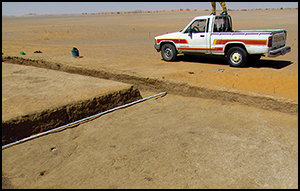Crossref Citations
This article has been cited by the following publications. This list is generated based on data provided by
Crossref.
Linseele, Veerle
and
Zerboni, Andrea
2018.
Done with fish? A diachronic study of fishing in the Holocene Nile basin of Sudan.
Quaternary International,
Vol. 471,
Issue. ,
p.
229.
Stewart, Mathew
Louys, Julien
Price, Gilbert J.
Drake, Nick A.
Groucutt, Huw S.
and
Petraglia, Michael D.
2019.
Middle and Late Pleistocene mammal fossils of Arabia and surrounding regions: Implications for biogeography and hominin dispersals.
Quaternary International,
Vol. 515,
Issue. ,
p.
12.
Osypinska, Marta
Osypinski, Piotr
Belka, Zdzislaw
Chlodnicki, Marek
Wiktorowicz, Paweł
Ryndziewicz, Robert
and
Kubiak, Michał
2021.
Wild and Domestic Cattle in the Ancient Nile Valley: Marks of Ecological Change.
Journal of Field Archaeology,
Vol. 46,
Issue. 7,
p.
429.
Osypiński, P.
Burrough, S.
Skinner, A.
and
Standzikowski, K.
2021.
Re‐examining the age of the Affad MSA deposits in the Middle Nile Valley.
Archaeometry,
Vol. 63,
Issue. 6,
p.
1405.
Vella Gregory, Isabelle
and
Brass, Michael
2021.
Encyclopedia of Global Archaeology.
p.
1.
Ehlert, Maciej
Kim, Ju Yong
Sohn, Young Kwan
Cendrowska, Marzena
Krupa-Kurzynowska, Joanna
Andrieux, Eric
Armitage, Simon J.
Michalec, Grzegorz
Dreczko, Ewa
Alkhidir, Hassan Mustafa
Szmit, Marcin
and
Masojć, Mirosław
2022.
The Middle Stone Age in the Eastern Desert. EDAR 135 — a buried early MIS 5 horizon from Sudan.
Azania: Archaeological Research in Africa,
Vol. 57,
Issue. 2,
p.
155.
Leplongeon, Alice
2022.
Le peuplement paléolithique de l’Afrique du Nord-Est dans son contexte macrorégional.
L'Anthropologie,
Vol. 126,
Issue. 2,
p.
103015.
Thompson, Jessica C.
Bertacchi, Alex
Keller, Hannah M.
Hallett, Emily Y.
and
Pobiner, Briana
2023.
Handbook of Pleistocene Archaeology of Africa.
p.
1955.
Michalec, Grzegorz
Andrieux, Eric
Kim, Ju Yong
Sohn, Young Kwan
Cendrowska, Marzena
Ehlert, Maciej
Armitage, Simon J.
Moska, Piotr
Szmit, Marcin
Nassr, Ahmed
and
Masojć, Mirosław
2024.
A Mismatched Piece in a Cultural Middle Stone Age Puzzle: Traces of Human Activity Dated to 90 kya (MIS 5) at Sites EDAR 134 and 155 in the Eastern Sahara, Sudan.
Journal of Field Archaeology,
Vol. 49,
Issue. 7,
p.
484.
